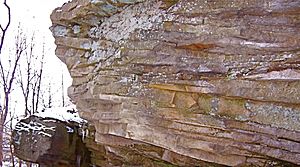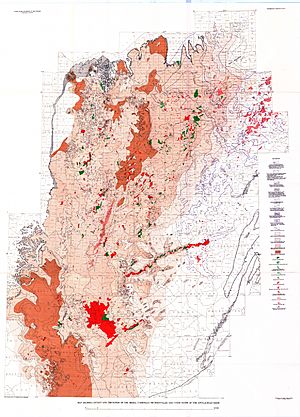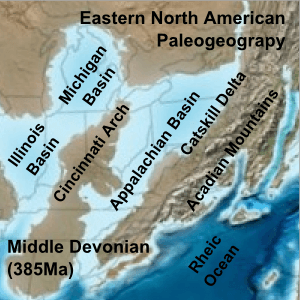Bedford Shale facts for kids
Quick facts for kids Bedford ShaleStratigraphic range: Late Famennian |
|
|---|---|

Bedford Shale at Brandywine Falls on Brandywine Creek near Boston Heights, Ohio
|
|
| Type | Formation |
| Unit of | Waverly Group |
| Underlies | Berea Sandstone |
| Overlies | Cussewago Sandstone, Cleveland Shale, and Ohio Shale |
| Location | |
| Country | United States |
| Type section | |
| Named for | Bedford, Ohio, U.S. |
The Bedford Shale is a shale geologic formation in the states of Ohio, Michigan, Pennsylvania, Kentucky, West Virginia, and Virginia in the United States.
Contents
Identification and name
John Strong Newberry, director of the Ohio State Geological Survey, first identified the formation in 1870. He called it the "Bedford Shale" and designated its type locality at Tinkers Creek near Bedford, Ohio.
Details of the type locality and of stratigraphic nomenclature for this unit as used by the U.S. Geological Survey are available on-line at the National Geologic Map Database.
The Bedford Shale in northern Ohio is a red, predominantly soft clay shale that grades to grayish-black near its base. Siltstone beds, showing ripples and some as much as 3 inches (7.6 cm) thick, are interbedded near the bottom. This red Bedford Shale consists mostly of sandstone and siltstone, and is much more argillaceous from mid-state Franklin County north-northeast to Lorain County on Lake Erie. Proceeding east from Lorain County, the silt content increases. The Bedford undergoes a marked lithologic change at the Cuyahoga River. It becomes equal parts red and gray shale, and the basal 12 feet (3.7 m) becomes a hard siltstone (the Euclid member, or Euclid siltstone). At Tinkers Creek in Bedford, Ohio, there is no red shale; instead there is about 85 feet (26 m) of gray and bluish-gray shale, nodules of light-gray mudstone, and brownish-gray to gray irregular beds of siltstone. East of the Grand River, the clay shale is largely replaced by silty gray shale, hard silty gray mudstone, and thin platy gray siltstone.
The red shale fades in intensity and thickness toward the south. South of Columbus, the color fades to reddish-brown and exists only as a bed a few feet thick between bluish or bluish-gray Bedford Shale. The Bedford in southern Ohio is almost completely a bluish-gray shale. Proceeding south from Ross and Pike counties, the Bedford turns from a soft clay shale to a gray silty shale interbedded with thin beds of gray siltstone in its upper parts. In Ross, Pike, and Scioto counties, siltstone in the Bedford increases so much that it becomes mostly siltstone interbedded with silty shale.
Generally, the red Bedford thins and grades into the gray Bedford all along its margin. Along the rough line from Huron to Lawrence counties, beds of mudrock may be found.
Throughout Ohio, a few thin layers of siltstone may be found in all types of Bedford Shale. These are calcareous and 2 to 4 inches (5.1 to 10.2 cm) thick in central Ohio. Siltstone beds increase in number and thickness in the upper part of the Bedford shale south of Columbus. In southern Ross County, the upper third of the Bedford contains a large number of layers of thin, platy siltstone as well as occasional thin layers consisting of blebs of calcium carbonate, marcasite, and pyrite. Oscillation ripple marks can be seen on the upper surfaces of these siltstones. Silty laminae become common toward the bottom of the Bedford Shale throughout the state, as do thin beds of gray silty mudstone (a fine-grained type of mudrock).
"Flow rolls" are a structure which appears unique to the Bedford Shale. These structures appear in the basal part of the formation. In a flow roll, the rock is greatly deformed and rolled into a cylindrical shape.
The Bedford Shale of Michigan is a light gray or bluish-light gray in color. It is a silty shale, siltier and sandier in its upper part. The boundary with the Berea Sandstone exhibits thin veins ("stringers") of sandstone, indicating erosion of the Bedford Shale which was filled in later by sand.
The Bedford Shale appears gray or greenish-gray in Kentucky, and contains sparse to abundant thin beds of siltstone, calcareous concretions, and nodules of pyrite. Limited areas of red Bedford Shale can be found in Boyd County. Siltstone and sandstone beds are particularly common from Lewis and Greenup counties southeast to Pike County; here, the Bedford is referred to as the "Berea sand".
Geographic Extent
The Bedford Shale is a shale geologic formation in the states of Ohio, Michigan, Pennsylvania, West Virginia, Ohio, and Virginia in the United States.
Ohio
The Bedford Shale in Ohio has been extensively studied since 1943, and the 1954 study by Pepper, de Witt, and Demarest was still considered the classic study of the formation as late as 1991.
The Bedford Shale is present throughout much of Ohio. Outcrops extend along Lake Erie from the Ohio-Pennsylvania border west to Lorain County. It runs in a generally southern direction to Lawrence County in the south. The southern border of Ohio along the Ohio River defines its southernmost boundary in the state. In eastern Meigs County, the boundary turns north and runs to north-central Athens County before turning northeast to run through western Washington County into Monroe County. It runs north through the center of Belmont and Jefferson counties, and in southern Columbiana County turns east to pass into Pennsylvania.
On average, the Bedford Shale in Ohio is 85 feet (26 m) to 95 feet (29 m) thick, reaching its maximum thickness between Huron and Lawrence counties. The shale is about 150 feet (46 m) thick along its central ridge between Lorain and Licking counties. In northern Ohio, the thickness of the Bedford is irregular due to erosion prior to the deposit of the Berea Sandstone, and due to recent glacial and stream erosion. The Bedford thins toward the south; near Columbus in central Ohio it is 95 feet (29 m) thick, and 85 feet (26 m) near Chillicothe 45 miles (72 km) to the south. It thins to the east as well, reaching 85 feet (26 m) near Bedford and 45 feet (14 m) in southwestern Ashtabula County.
Outcrops of the Bedford shale may be found throughout Cuyahoga, Lake, and Geauga counties in cliffs beneath the Berea sandstone. Outcrops are much fewer in Lorain County (west of Cuyahoga County). The Bedford appears only in deep valleys (such as those of rivers and large streams). The red shale weathers so swiftly into a sticky red mud that even these outcrops are usually covered by soil. South of the counties bordering Lake Erie, outcrops are usually covered by glacial drift. Occasional outcrops can be seen along streams that flow south into the Ohio River, particularly at Big Walnut Creek.
Michigan
In Michigan, the Bedford Shale is found in the southeast along shores of Lake Erie and Lake St. Clair; along the shore of Lake Huron north of Saginaw Bay; along the south shore of the Straits of Mackinac; north of 44 degrees latitude along the shore of Lake Michigan; and in the far southwest corner of the state. The Bedford Shale was first identified in Michigan in 1876 in the southeastern part of the state. Some sources say the shale is 50 to 100 feet (15 to 30 m) thick while others say it is generally about 60 feet (18 m) thick. It is almost 250 feet (76 m) thick in The Thumb of Michigan, and about 65 feet (20 m) thick in Southeast Michigan. The Bedford Shale becomes finer-grained and thins from Lake Erie/Lake St. Clair to the west, pinching out to extinction near the center of the Michigan Basin and merging with the upper part of the Ellsworth Shale. In south-central Michigan, the Bedford Shale grades into and intertongues with the Antrim Shale.
There are no known outcrops of the Bedford Shale in Michigan, as it and the rocks above it are covered by Pleistocene glacial drift.
Kentucky
The Bedford Shale is present throughout much of eastern Kentucky. It is thickest in north (in Lewis County), thinning out to extinction in Bath, Estill, and Pike counties as it proceeds south and west. It is about 100 feet (30 m) thick in Letcher and Pike counties, which were closest to the Famennian deltas being deposited from the east and southeast. The Bedford Shale essentially forms a great wedge underground, with the narrow edge in the southwest.
The Bedford Shale in Kentucky is covered in thin soil and heavily weathered sandstone blocks. Outcrops of the rock may be seen along the Pine Mountain ridge in Harlan County. In Kentucky, a transition zone ranging from a few inches to 4.2 feet (1.3 m) in thickness occasionally appears as the basal member of the Bedford Shale.
Pennsylvania
Bedford Shale is found in Crawford County, Pennsylvania, where it is also known as "Hayfield limestone". It is extremely lenticular and highly localized, and gray to bluish-gray in color. It is frequently interbedded with ripple marked siltstone, and contains a few thin siliceous limestone layers. It overlays the Cussewago Sandstone and is overlain by the Berea Sandstone. The Bedford is 44 feet (13 m) feet at Littles Corners in Hayfield Township, and decreases to 22 feet (6.7 m) thick 8 miles (13 km) northwest of Meadville. It thins rapidly and loses its identity around Meadville, where it grades into the Shellhammer Hollow Formation. Fucoids in the shale can be seen on Stratton Creek.
West Virginia
The Bedford Shale has also been traced into West Virginia. It may be found in the subsurface along the Ohio River in Mason, Cabell, Wayne, and Mingo counties. Its edge cannot be readily determined, as the Bedford's gray shale and interbedded siltstones overlay extremely similar Early Famennian rocks. However, the Bedford Shale appears to pinch out in southern Mingo County. The Bedford Shale may exist in northern West Virginia, but had not been identified there as of 1979.
Virginia
Bedford Shale has also been identified in the Dickenson-Buchanan county area in southwestern Virginia.
Stratigraphic Setting
The Bedford Shale is the basal member of the Waverly Group, which (in ascending order) includes the Bedford Shale, Berea Sandstone, Sunbury Shale, Cuyahoga Formation, Logan Formation, and the Maxville Limestone.
Generally, the Bedford Shale in Ohio is underlain by the Cleveland Shale throughout most of Ohio, although it is underlain by the Chagrin Shale in the east. The boundary with the Cleveland Shale is usually clear. However, a transition zone, ranging from a few inches to 4.2 feet (1.3 m) in thickness, occasionally appears. The transition zone is missing along most of the western edge of the red Bedford Shale in northern Ohio, and only at a few places are thin stringers of black shale found in the basal part of the Bedford. Above the transition layer, there is usually about 15 feet (4.6 m) of gray shale. This represents the basal part of the Bedford Shale. This gray shale thickens significantly east of Cuyahoga River, and to the south as the red shale pinches out. It is difficult to impossible to visually determine the boundary with the Chagrin Shale due to its lithologic similarity with the Bedford. In eastern Ashtabula and Trumbull counties, the Bedford overlays the Cussewago Sandstone.
The Bedford Shale is generally overlaid by the Berea Sandstone throughout Ohio. The contact between the two is generally clear but extremely irregular. Pre-Berea and Berean erosion eroded significant portions of the red Bedford Shale in northern Ohio. For example, near Berea, Ohio, 85-foot (26 m) deep channels were scoured into the Bedford Shale. Sand filled these channels, and became Berea Sandstone. To the southwest, in Huron County, these channels cut down to the Cleveland Shale. Along Ohio's eastern border, in Columbiana, Mahoning, and Trumbull counties, erosion has almost completely removed the Bedford Shale. Erosional channeling becomes less marked toward the south-central Ohio. Near Columbus, the channels are only about 5 feet (1.5 m) deep, and they disappear south of Lithopolis (which is 7 miles (11 km) southeast of Columbus). In southern Ohio, the Bedford and Berea grade into one another so gradually that the boundary between them cannot be distinguished visually.
The Bedford Shale in Michigan is generally overlaid by the Berea Sandstone. The upper part of Bedford in this state is silty and sandy, making the boundary between it and the Berea sandstone nearly impossible to identify visually. The boundary may be determined by gamma ray logging, however. In eastern Michigan, the Bedford Shale overlays the Antrim Shale. Toward the center of the Michigan Basin, the Bedford overlays the Ellsworth Shale. The boundary between the two becomes increasingly difficult to identify as one proceeds west, as the Bedford merges laterally into the upper 97 feet (30 m) of the Ellsworth Shale.
In the vicinity of Irvine (Michigan), the black shale of the Sunbury comes in contact with the black shale of the Ohio shale as a result of the feathering out of the Berea and Bedford strata.
Generally, the Bedford Shale in Kentucky is underlain by the Ohio Shale and overlaid by the Berea Sandstone. The Bedford Shale's upper and lower contacts are usually sharp in the state, but complicated by intense deformation. In much of eastern Kentucky, the Bedford Shale and Berea Sandstone intertongue (interlock). Near Vanceburg, the upper 40 feet (12 m) of the Bedford Shale is silty shale that comes between the Bedford and Berea siltstone. Only 4 miles (6.4 km) to the east near Garrison, Bedford is almost completely siltstone. Just 18 miles (29 km) south, near Petersville, the Bedford has almost no siltstone layer. There are only a few thin siltstone beds present, and the Bedford grades almost imperceptibly into the Berea—both of which are composed of bluish-gray to gray clay shales and some gray silty shale. In southern Lewis County, there is no Bedford siltstone; the upper portion of the Bedford is a noticeably soft bluish-gray shale. Near Olympia in Bath County, the Berea Sandstone is not found and the Sunbury Shale overlies the Bedford, while near Irvine in Estill County to the south both the Berea and Bedford are missing and the Sunbury lies atop the Ohio Shale.
Fossils
Except for its lowest strata, the Bedford Shale is largely fossil-free. In central and north-central Ohio, the Bedford Shale contains extensive fossils in the first few feet of its bottommost part. These include brachiopods like Lingula, Orbiculoidea, and the large Syringothyris bedfordensis; molluscs, particularly bivalves; and Devonian fish. South of Ross County, most of the siltstones in the Bedford Shale show fucoids (casts of Fucales, a common littoral seaweed).
The basal 1 to 5 feet (0.30 to 1.52 m) of the Bedford Shale in Michigan contains extensive fossils of the Famennian stage. Small amounts of natural gas have been recovered from the shale as well.
In Kentucky, a transition zone ranging from a few inches to 4.2 feet (1.3 m) in thickness occasionally appears as the basal member of the Bedford Shale in Kentucky. Invertebrate fossils are found at the top of this transition zone in northeast Kentucky.
Age
Although there have been conflicting reports in the past, the most recent evidence is that the rock was laid down very late in the Famennian stage of the Devonian period. This makes the rock about 365 to 358.9 million years old. The age of the Bedford Shale has seen significantly different interpretations over time. Some geologists have placed it exclusively in the upper Devonian while others have concluded it is exclusively lower Carboniferous. Still others have placed the Devonian-Carboniferous boundary in the basal few inches or feet of the Bedford Shale. Depending on the source, the rock began to be laid down either 360 million years ago or 365 million years ago. and finished being laid down at the end of the Famennian 358.9 million years ago.
In their 1991 review of the literature, geologists Raymond C. Gutschick and Charles A. Sandberg point out that the Bedford Shale is correctly assigned to the upper Devonian. The 1975 Devonian-Carboniferous Boundary Working Group of the International Union of Geological Sciences engaged in an extensive study of brachiopod, conodont, and spore fossils in the Bedford Shale and Berea Sandstone, and found no evidence of lower Mississippian conodonts in either rock formation. The American definition of the Devonian period was realigned to match the definition already in use in Europe, which led to the placement of both formations in the Famennian stage of the upper Devonian.
Economic Resources
Native Americans used heavily weathered Bedford Shale for its reddish pigment. Colonial French traders named Vermillion River after the Bedford's red shale. Weathered Bedford Shale was also used in the 1800s and early 1900s to make face brick (a brick used on exterior surfaces to present a clean appearance) and tile.



